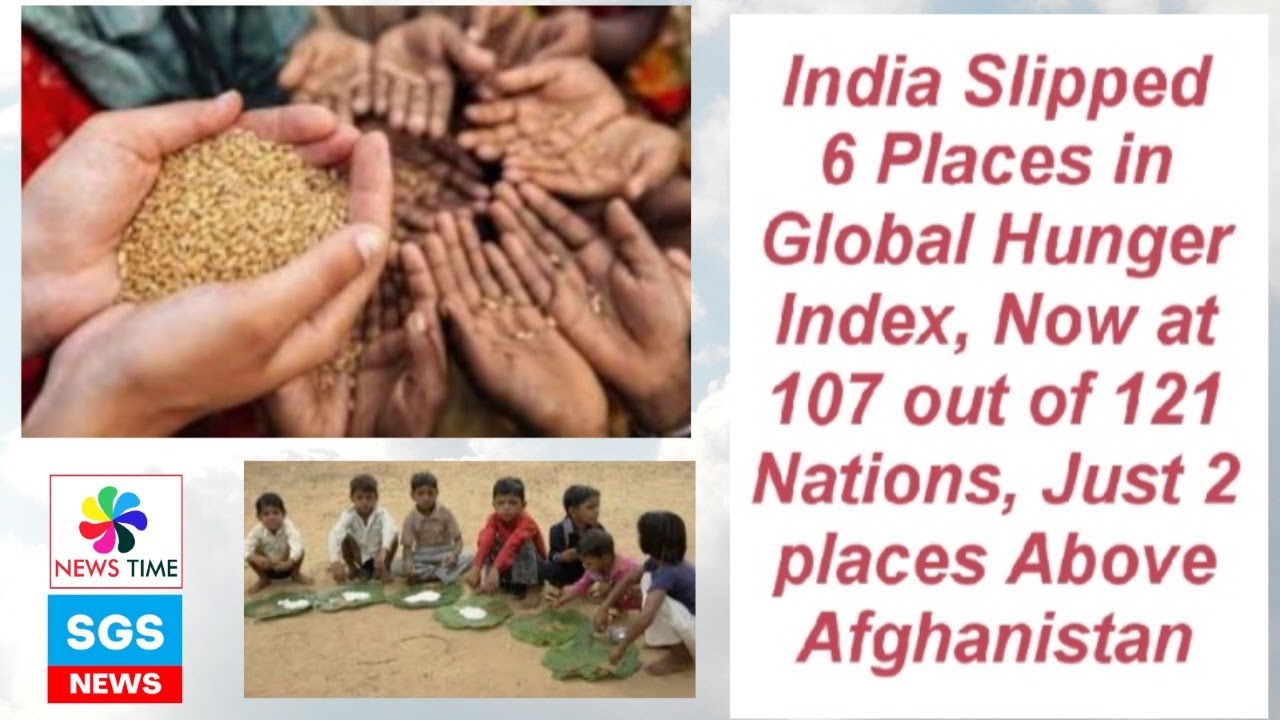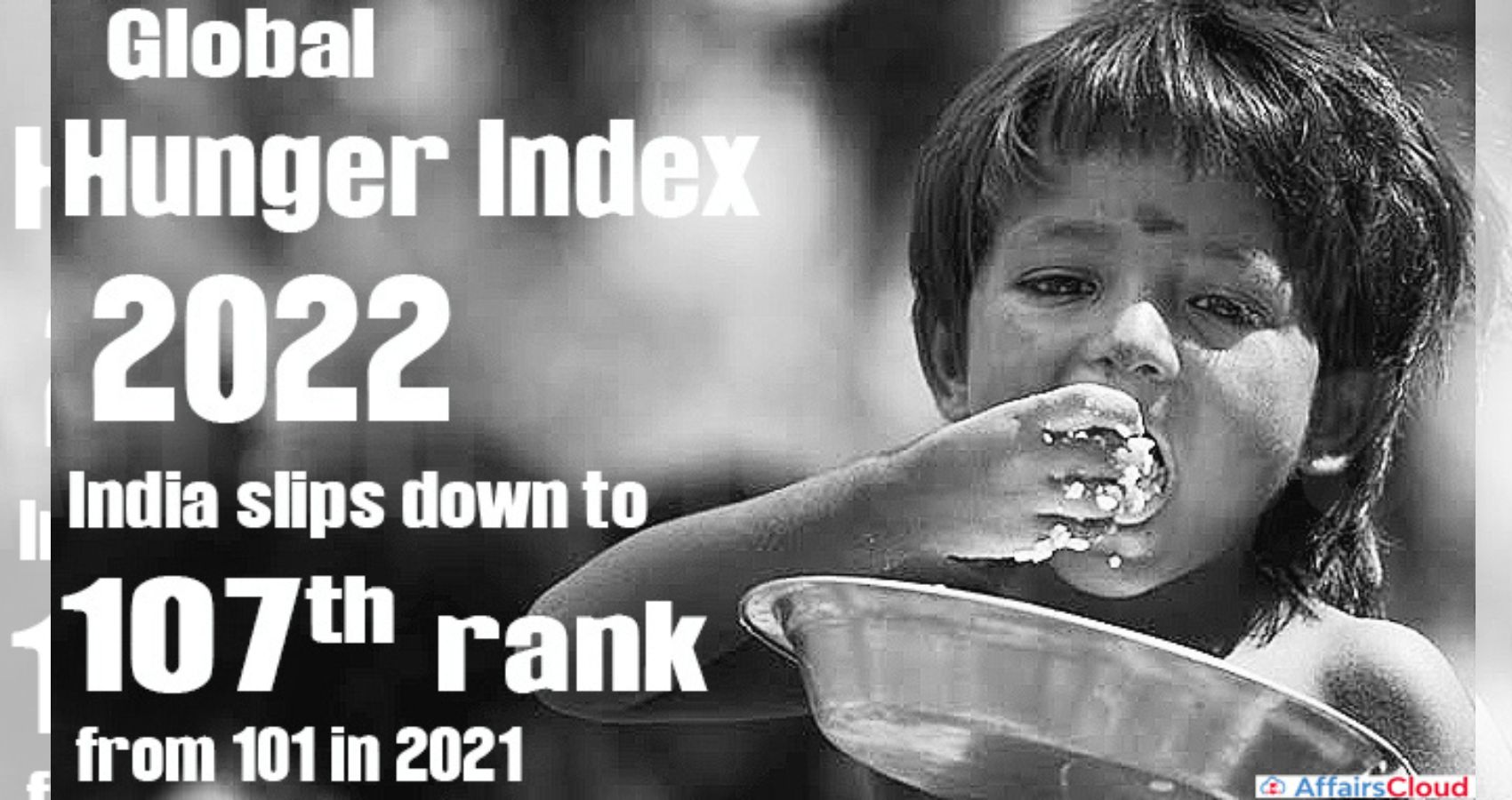In the 2022 Global Hunger Index, India ranks 107th out of the 121 countries with sufficient data to calculate 2022 GHI scores. India was ranked 101st in the 2021 ranking.
With a score of 29.1, India has a level of hunger that is serious. It was 28.2 in 2014. The higher the score, the worse is the situation, according to the methodology. There are five levels of hunger severity, according to this methodology. Scores of ≤ 9.9 are Low; 10.0–19.9 are Moderate; 20.0–34.9 are Serious; 35.0–49.9 are Alarming; and ≥ 50.0 are Extremely Alarming.
At 19.3 per cent, according to the latest data, India has the highest child wasting rate of all countries covered in the GHI. This rate is higher than it was in 1998-1999, when it was 17.1 per cent. Child wasting is the share of children under the age of five who have low weight for their height, reflecting acute undernutrition.
Nepal is ranked higher at 81, Bangladesh at 84 and even Pakistan at 99. India is ranked below African countries like Sudan, Congo, Ethiopia, Nigeria, and Rwanda.
The Global Hunger Index is a peer-reviewed annual report, jointly published by Concern Worldwide and Welthungerhilfe, designed to comprehensively measure and track hunger at the global, regional, and country levels. The aim of the GHI is to trigger action to reduce hunger around the world.
According to the data analysts, since 2000, India has made substantial progress, but there are still areas of concern, particularly regarding child nutrition.
 India’s GHI score has decreased from a 2000 GHI score of 38.8 points, considered alarming, to a 2022 GHI score of 29.1, considered serious. India’s proportion of undernourished in the population is considered to be at a medium level, and its under-five child mortality rate is considered low.
India’s GHI score has decreased from a 2000 GHI score of 38.8 points, considered alarming, to a 2022 GHI score of 29.1, considered serious. India’s proportion of undernourished in the population is considered to be at a medium level, and its under-five child mortality rate is considered low.
While child stunting has seen a significant decrease — from 54.2 per cent in 1998-1999 to 35.5 per cent in 2019-2021 — it is still considered very high.
Each country’s GHI score is calculated based on a formula that combines four indicators that together capture the multidimensional nature of hunger:
Undernourishment: the share of the population with insufficient caloric intake.
Child stunting: the share of children under age five who have low height for their age, reflecting chronic undernutrition.
Child wasting: the share of children under age five who have low weight for their height, reflecting acute undernutrition.
Child mortality: the share of children who die before their fifth birthday, partly reflecting the fatal mix of inadequate nutrition and unhealthy environments.
Hunger is usually understood to refer to the distress associated with a lack of sufficient calories. The Food and Agriculture Organization of the United Nations (FAO) defines food deprivation, or undernourishment, as the habitual consumption of too few calories to provide the minimum dietary energy an individual requires to live a healthy and productive life, given that person’s sex, age, stature, and physical activity level.
Undernutrition goes beyond calories and signifies deficiencies in any or all of the following: energy, protein, and/ or essential vitamins and minerals. Undernutrition is the result of inadequate intake of food in terms of either quantity or quality, poor utilization of nutrients due to infections or other illnesses, or a combination of these immediate causes. These, in turn, result from a range of underlying factors, including household food insecurity; inadequate maternal health or childcare practices; or inadequate access to health services, safe water, and sanitation.
Malnutrition refers more broadly to both undernutrition (problems caused by deficiencies) and overnutrition (problems caused by unbalanced diets that involve consuming too many calories in relation to requirements, with or without low intake of micronutrient-rich foods). Overnutrition, resulting in overweight, obesity, and noncommunicable diseases, is increasingly common throughout the world, with implications for human health, government expenditures, and food systems development. While overnutrition is an important concern, the GHI focuses specifically on issues relating to undernutrition. (IndicaNews)
Author: Indica News
Spouses Of H-1B Visa Holders Can Now Look Forward To Getting Work Permit Faster
The Biden administration has been making gradual changes in the immigration department to make it easier for foreign professionals to travel to US, unlike the previous administration.
In the past few months, President Biden has been signing off crucial documents that will let IT professionals find working in the US more comfortably.
One of the major issues many H-1B visa holders facing were getting work permit for their spouses in the US.
Several visa holders, especially, Indian American has been urging the Biden admin to take this into consideration.
 Now the administration has agreed to provide automatic work authorization permits to the spouses of H-1B visa holders, most of whom are Indian IT professionals.
Now the administration has agreed to provide automatic work authorization permits to the spouses of H-1B visa holders, most of whom are Indian IT professionals.
An H-4 visa is issued by the US Citizenship and Immigration Services (USCIS) to immediate family members (spouse and children under 21 years of age) of the H-1B visa holders. The visa is normally issued to those who have already started the process of seeking employment-based lawful permanent resident status in the US.
The H-1B visa is a non-immigrant visa that allows US companies to employ foreign workers in specialty occupations that require theoretical or technical expertise. The technology companies depend on it to hire tens of thousands of employees each year from countries like India and China.
A settlement was reached by the Department of Homeland Security in a class-action lawsuit, which was filed by the American Immigration Lawyers Association (AILA) on behalf of immigrant spouses this summer.
“This (H-4 visa holders) is a group that always met the regulatory test for automatic extension of EADs (employment authorization documents), but the agency previously prohibited them from that benefit and forced them to wait for reauthorization. People were suffering. They were losing their high-paying jobs for absolutely no legitimate reason causing harm to them and US businesses,” Jon Wasden from AILA said.
The litigation successfully achieved the reversal of the USCIS policy that prohibited H-4 spouses from benefiting from the automatic extension of their employment authorization during the pendency of stand-alone EAD applications.
“Although this is a giant achievement, the parties’ agreement will further result in a massive change in position for the USCIS, which now recognizes that L-2 spouses enjoy automatic work authorization incident to status, meaning these spouses of executive and managers will no longer have to apply for employment authorization prior to working in the United States,” AILA said.
“We are delighted to have reached this agreement, which includes relief for H-4 spouses, through our litigation efforts with Wasden Banias and Steven Brown. It is gratifying that the administration saw that settling the litigation for non-immigrant spouses was something that should be done, and done quickly,” said Jesse Bless, AILA director of federal litigation.
The Obama administration had given work authorization to certain categories of spouses of H-1B visa holders. So far, more than 90,000 H-4 visa holders, a significant majority of whom are Indian-American women, have received work authorization.



